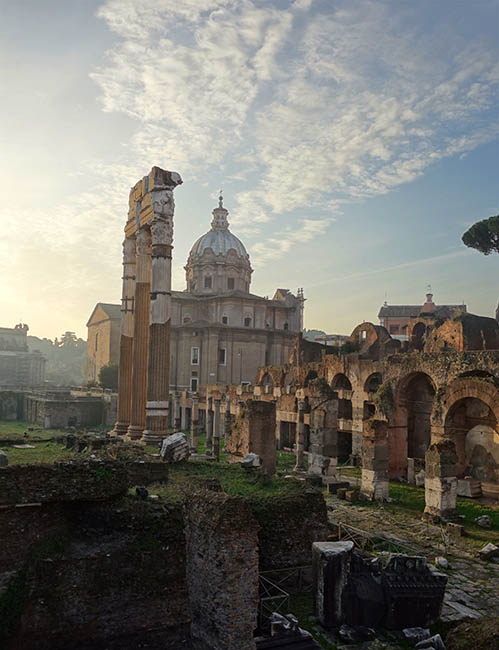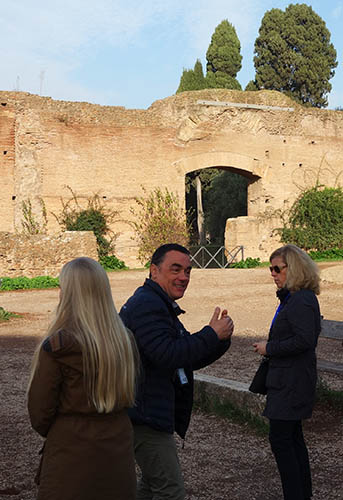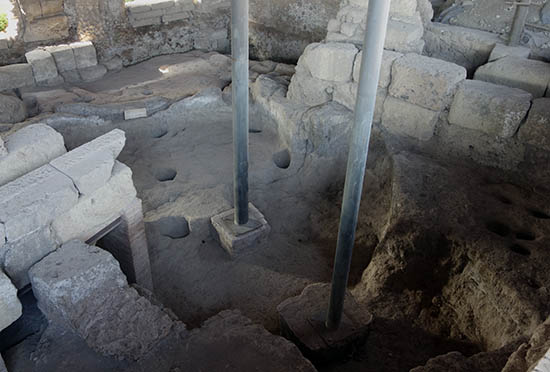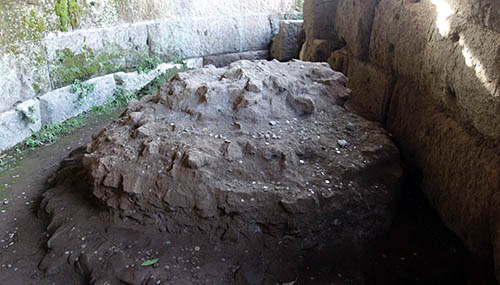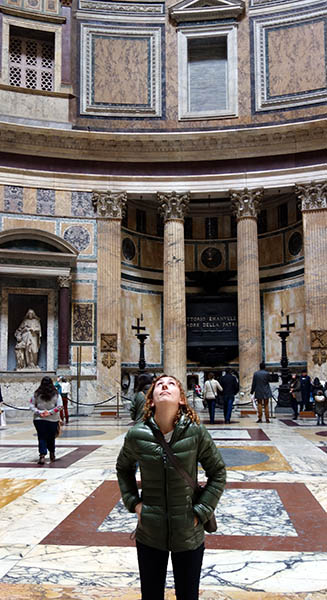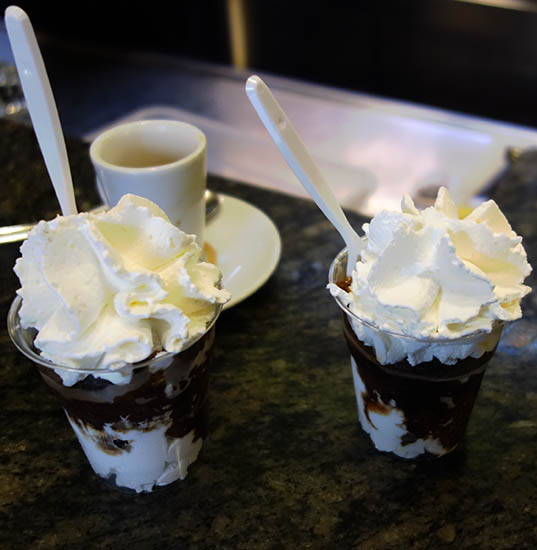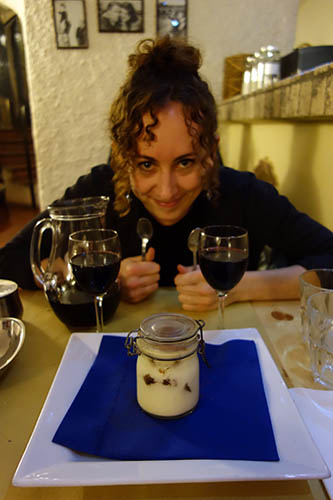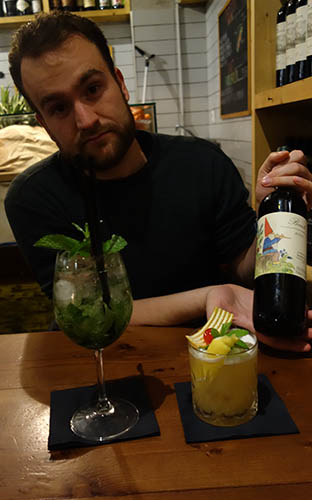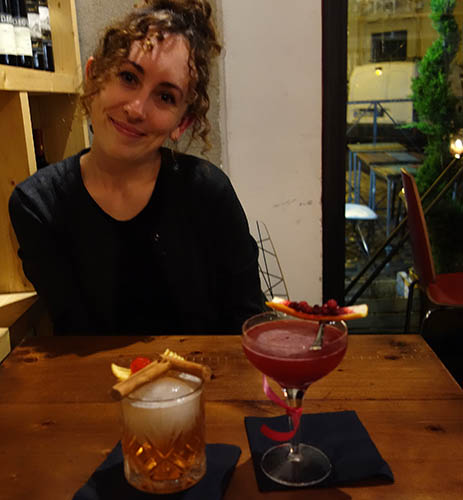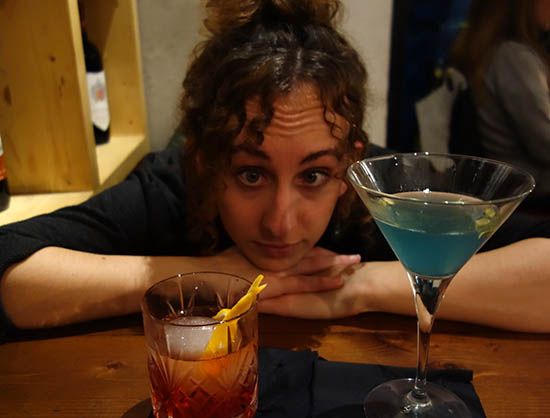Before leaving for Italy, Alex and I had talked about taking a few tours. We’d signed up for the one in Tuscany, but I’d also signed up for a surprise tour – one of the Colosseum and Palatine. I suspected that these sights wouldn’t be a great experience on their own, because without any context, it’s just a lot of ruins.
The downside was the we had to wake up early, but we got a good view of the triangle marked off by the Colosseum, forum and Palatine hill while it was quiet, without too many non-commuter crowds.
We met at the subway/bus stop outside the Colosseum; our tour group was about 10 people, all American except for a Malaysian couple. Our guide was a very energetic Rome native (one who had strong opinions about Italian government).
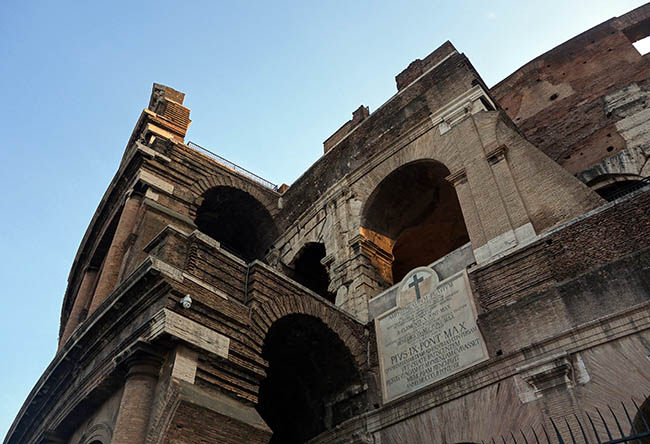
The Colosseum is now a Christian holy sight, because there’s a legend that Christians were persecuted there.
The first stop was the Colosseum. You see a lot of pictures of the Colosseum, and digital representations in movies like Gladiator, but I guess I’d never really tried to visualize what it would be like. It managed to be both bigger and smaller than I expected. Bigger, because the outside really dominates the area around it. Smaller, because the inside was cozier than i expected (even though it was large). It felt smaller than the Colosseum represented in Gladiator.
First off, the Colosseum is in the middle of a traffic circle. There really aren’t any stores or restaurants or apartments nearby, just a busy street and a lot of ruins. The inside is raw: there’s a small section with reproduction flooring and sand, but most is in an un-reconstructed state. It works great as a museum, and to visualize what sort of hell it must have been in the corridors underneath the floor. But, on the other hand, it’s difficult to imagine what the Colosseum would have looked like in its heyday. This was in contrast to the arena in Verona, which is still in use.
From the Colosseum, it’s a short walk to the Palatine. This was one of my favorite spots in Rome. It functions as a sort of giant park, but also a huge archaeological site. The Palatine hill is one of the famous seven hills of Rome, and the one that was used as a residence for the Roman emperors (due in part to its proximity to the forums). From the word ‘Palatine,’ we get the English word ‘palace’ (Italian: ‘palazzo’).
It’s a peaceful place, quiet, with a lot of interesting views (after all, it’s on a hill). You can see the Circus Maximus, the Colosseum, and even the Vatican, from various locations.
Two sights in particular stuck out for me. First, there’s a small section of the throne room. It’s not something that you often hear about, if you read about Rome. It just somehow escapes notice. But of course, there must have been at least one throne room, and in fact, it’s possible to stand in the location where the throne was located. That was very cool to me, picturing Marcus Aurelius or Trajan in the same spot where I stood.
Second, there’s a claustrophobic group of stone ruins on the far side of the Palatine, covered with an aluminium roof. This was the mythical hut of Romulus, the founder of Rome. The hut was diligently maintained by the ancient Romans. Although the founding of Rome is shrouded in myth, archaeologists believe this was inhabited around the time that Rome was founded, or maybe by the Etruscans before. I loved seeing a spot that the Romans considered so important.
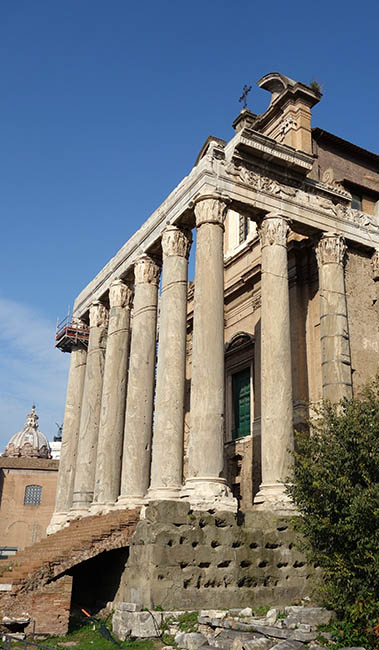
After the sack of Rome, Visigoths unsuccessfully attempted to pull down these columns (you can see where the chains dug into the stone). Those coming after the Roman empire couldn’t even destroy what the Romans had built.
Heading down from the hill, we got an inside view of one section of the forum (half of the forum requires an entry fee; the other half is free. The forum is bisected by a huge road constructed by Mussolini). It’s simply impossible to visualize what this area looked like at any point in time. There’s structures at various heights and from various periods, in all sorts of disarray. During the middle ages, this area was deserted, and silted over when the Tiber flooded; herds of animals grazed here while the population of the depleted city lived across the river, near the Vatican.
Two more sites of interest in this area were the mound where Julius Caesar’s body was burned (the mound is still visible – people throw coins on it for good luck). Also, there’s a prominent nearby location where Mark Antony gave a speech to the people of Rome.
After leaving the Palatine hill, we grabbed a quick lunch (more pizza for me), before taking a walk to the Pantheon. We’d seen the outside, at night, but now it was time to check out the inside.
The Pantheon is widely known as one of the architectural marvels of the world. The inside is basically a huge poured-concrete dome with an open center to provide light. The dome was great – but of course they’re relatively common these days. More exciting to me, was a chance to get a look inside one of the best-preserved Roman buildings in the world. The Romans employed a huge variety of marbles in their construction (something we’d seen around the other ruins), and the Pantheon was preserved mostly intact as a Christian church.
Just around the corner is a great coffee shop: Tazza d’Oro (Gold Cup). I’d read they had great granita, and this was one of the food highlights of our trip. Granitas are like a layer cake, where the layers are crystallized espresso and whipped cream. The coffee flavor was just incredibly intense, but balanced out by the sweetness of it all. Really strong!
Next, we crossed the Tiber and walked around the parks there – seeing, among other things, miniature horses, parrots, the Vatican, memorials to Italian independence, the Spanish consulate, and a merry-go-round.
After dinner (generic Italian food; tiramisu), we stopped at a fancy bar. They served all sorts of mixed drinks and cocktails. We had several rounds.
We started on the menu, but one of the bartenders came over to take our order for the next round. “Do you have any suggestions from the menu?” we asked. “I wrote the menu.” So, we let him choose for us.
For several rounds. I think he was trying out some new drinks that were off-menu. There were at least three amazing drinks: a mint julep with Saint Germain, a cinnamon rum drink, and a lemon daquiri. There were some other tasty drinks, but these were absolutely amazing. We agreed that our bartender was a genius.
And had quite a bit to drink. When we left the bar, there was a crowd of maybe 10 people outside, drinks raised, clustered around the bartender, who was giving some sort of speech. Cheers!

